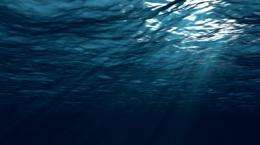Iron fertilization less efficient for deep-sea carbon dioxide storage than previously thought?

Ian Salter from the Alfred Wegener Institute and a team of international collaborators discovered that iron fertilization promotes the growth of shelled organisms. In a naturally iron-fertilized system in the Southern Ocean the growth and sinking of these phytoplankton grazers reduces CO2 deep-ocean storage by up to 30 percent. Ignoring this response could result in overestimating the marine CO2 storage capacity resulting from iron fertilization. The study is published by Nature Geoscience.
The Southern Ocean plays an important role in the exchange of carbon dioxide between the atmosphere and the ocean. One aspect of this is the growth of phytoplankton, which acts as a natural sponge for carbon dioxide, drawing the troublesome greenhouse gas from the atmosphere into the sea. When these plankton die they can sink to the bottom of the ocean and store some of the carbon dioxide they have absorbed, a process scientists call the "biological carbon pump".
Although many areas of the Southern Ocean are rich in nutrients, they often lack iron, which limits phytoplankton growth. An important idea in oceanography is that adding iron to the Southern Ocean could stimulate phytoplankton growth and the biological carbon pump. Some scientists believe that this process can partly explain cycles in atmospheric carbon dioxide over Earth's recent history and it has also been widely debated as a mitigation strategy for climate change.
In two previous studies carried out in the last five years it has been shown that iron fertilization of the Southern Ocean can export carbon dioxide to the deep-sea. "However, to understand the net storage of carbon dioxide in the ocean interior, sinking phytoplankton are only one part of the story", explains Dr. Ian Salter from the Alfred Wegener Institute, Helmholtz Centre for Polar and Marine Research. "These phytoplankton can be a food source for certain types of planktonic grazers, foraminifer and pteropods, that make shells from calcium carbonate - a process which produces carbon dioxide".
The biogeochemist, and an international team of collaborators, were the first to quantify production and sinking of these calcium carbonate shells resulting from a phytoplankton bloom in the Southern Ocean, close to the Crozet Islands, with surprising results. Natural fertilization, caused by iron leached from the basaltic islands, increased the production and sinking of these calcium carbonate shells to a greater extent than sinking phytoplankton. This has important implications for the deep-sea storage of the carbon dioxide resulting from these blooms.
"The production and sinking of these calcium carbonate shells affects the balance of carbon dioxide in the surface ocean over 100 to 1000 year timescales", explains Dr. Ian Salter. "Our calculations suggest that this process reduces the amount of carbon dioxide transferred to the ocean interior via sinking phytoplankton by up to 30 per cent in this naturally fertilized system. However, it is unclear that purposefully added iron would have the same impact."
Interestingly the reduction in the efficiency of the biological carbon pump was not just caused by a higher abundance of these organisms, but also by changes in species composition. "In our samples from iron fertilized areas we found more species that produce larger calcium carbonate shells, and in turn produce more carbon dioxide per individual", explains the biogeochemist. Iron fertilization can therefore affect biodiversity and ecosystem structure with important knock-on effects for climate interactions. "It is important to recognise that our findings are only from a specific area of the Southern Ocean. The ecology of these shelled organisms can be very different depending on the species and exactly where in the ocean they live", cautions Dr. Ian Salter.
In future research projects Dr. Ian Salter will continue to investigate the sinking of phytoplankton and shelled calcifying organisms in other naturally iron-fertilized areas of the Southern Ocean, in addition to the Arctic Ocean, where melting sea ice conditions may also affect this delicate balance.
More information: Salter, et al.: Carbonate counter pump stimulated by natural iron fertilization in the Polar Frontal Zone. Nature Geoscience, DOI: 10.1038/ngeo2285
Journal information: Nature Geoscience
Provided by Helmholtz Association of German Research Centres


















